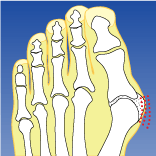

Foot complaints:
Flat foot
It is characterized by a flattened longitudinal vault and transverse vault, which remains in place even in an unloaded state. Even laypeople can easily recognize this foot malposition from the footprint, which shows the entire foot surface. There is a congenital and an acquired flat foot. The acquired is a consequence of the overloaded supporting apparatus of the foot, often from long standing on hard ground or permanent sitting. Connective tissue weakness, joint inflammation, obesity or poor footwear also promote the development of flat feet.
With flat feet, as well as with arches, there is a risk that the tendon plate of the sole of the foot will become inflamed as a result of permanent overuse, and that this will cause heel pain at the base of the tendon plate. As flatfoot develops, people often experience pain after exertion. Once it is fully developed, the pain decreases or disappears completely.
Congenital flat feet are rather rare and often occur in combination with other foot malformations. Because certain tarsal bones
If you are in the wrong position here, the foot not only lacks the longitudinal arch, but the sole is even arched downwards. Since the development of walking and mobility is impaired in many children, therapy is recommended, often beginning as early as babies.
Further misalignments at a glance
Buckle foot
With the buckle foot, the inner edge of the foot is lowered and the outer edge is raised. This is a weakness in the foot muscles that normally support the arch of the foot. This weakness is normal in small children and is regulated by the age of six or seven; otherwise it is referred to as a foot malposition. The buckle foot is initially neglected until its long-term consequences, such as flat, flat or splayfeet, occur.
Arched feet
In the case of a flat arch, the natural longitudinal arch sinks downwards. The arch of the foot is usually one to two fingers wide. It is a weakened form of the flat foot; the transitions are fluid. The foot muscles are too weak to stabilize the arches of the foot in a flat foot. Going barefoot a lot, foot exercises and good shoes counteract this.
splayfoot
With splayfoot, the metatarsal bones deviate, the anterior transverse arch is flattened and the middle metatarsophalangeal joints are overloaded. The forefoot is widened and calluses often form on the underside.
The cause of this misalignment is weak connective tissue, excess weight and, above all, high heel shoes - these increase the weight on the forefoot up to five times the normal weight. Overloading from standing for long periods of time and exercising in unsuitable shoes also favor splayfoot.
Arches foot
The arches foot is practically the opposite of the flat foot. The classic footprint narrows until it looks divided into two parts because the middle is no longer in contact with the ground. The foot becomes immobile, the longitudinal arch is excessive, stiff and rigid, pain and calluses can occur. The toes are permanently curved and stiff.
Most of the body weight rests on the heel and forefoot, which maintains the mobility of the foot, but not its elasticity. This can lead to an overload of the ligaments in the area of the ankle and thus to frequent twisting.
If the heel is bent outwards in the arches of the foot, it is referred to as “real arches”, if it is bent inwards it is called “pseudo arches”. The misalignment can be congenital or develop in the course of life, for example as a result of neurological diseases.
Hammer and claw toes
The hammer toe is a bent position in the toes. The toes claw due to a shortening of the tendons. The cause is a sunken transverse vault; this increases the pressure on the tendons running in the arch and shortens them.
Hallux rigidus
Hallux rigidus is the medical term for a stiffening of the base joint on the big toe. This stiffening is usually caused by arthritic wear, uncorrected misalignments (e.g. Hallux valgus), wrong shoes or sports that are associated with greater stress. During this process, the joint cartilage is destroyed and bony additions form on the joint surfaces, which make it difficult to roll while walking and can cause great pain.
Tailor's Bale
The tailor's ball is a misalignment of the little toe, similar to hallux valgus on the big toe. It is often the result of an untreated splayfoot when the outer edge of the foot is exposed to increasing pressure. The development is accelerated by wearing high shoes. The name of this foot deformity comes from the fact that many tailors often had to deal with this problem due to long periods of sitting cross-legged. The tailor's ball often occurs in connection with rheumatic diseases.
Haglund's heel / proximal heel spur
The Haglund heel is a thickening on the upper heel in the form of a bony protrusion. Inflammation of the bursae that protects the Achilles tendon causes the tendon to rub against the heel bone. Haglund's heel is also often associated with a hollow foot position. It is often found in runners and when using the wrong shoes because they are too sturdy in the heel area.
Morton's neuralgia / neuromas
Morton's disease is a cause of forefoot pain caused by nerves running in the bottom of the foot. Radiations to the toes are often associated with a feeling of numbness or sleep, as well as along the instep. Some patients also describe foreign body feelings like
"Grains of rice" or a sock fold under the sole of the foot. The pain often occurs in tight shoes under stress.



